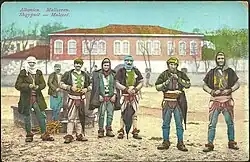Mazreku (Epirus)
The Mazreku, or alternatively, the Mazaraki, Mazarech and Masarachi, were a historical Albanian tribe in medieval Epirus and Thessaly. They appear in historical records as one of the Albanian tribes which raided and invaded Thessaly after 1318 and throughout the 14th century were active in the struggles of the Albanian Despotate of Arta against the Despotate of Epirus.
| Part of a series on |
| Albanian tribes |
|---|
 |
Name and Toponomy
Toponyms connected to the Mazaraki are spread widely across Albanian-inhabited lands; the Mazaraki of Epirus are the namesake of two toponyms (both called Mazaraki) near Ioannina and near Paramythia. Additionally, the toponym Mazaraki exists elsewhere in Epirus, in the eparchy of Patras, whilst the toponym Mazarakia is present in the eparchy of Margariti; there is also a Mazarakati in Cephalonia and Mazarakianika in Attica-Boeotia.[1]
John VI Kantakouzenos's History, which was written in the second half of the 14th century, mentions that the "Albanian tribes of Mazaraki, Bua, Malakasi were named so after the names of their leaders." Albanian clans traditionally bore the name of their first leader or progenitor, but after intermarriage between different leading families, the identification of the clans became intricate.[2]
History
During the second half of the 14th century, the Mazaraki tribe, alongside the fellow Albanian Malakasi tribe, were led by Pjetër Losha, an Albanian nobleman of Epirus. Losha led the Albanian force against Nikephoros II Orsini at the Battle of Achelous in 1359, which won him the rule of Arta; he founded his domain, the Despotate of Arta, around the city of Arta with the help of the Mazaraki and Malakasi clans.[3]
The Mazaraki regularly supported local Albanian leaders in their struggles against the Despotate of Epirus. In 1366, Thomas Preljubović succeeded Simeon Uroš as the ruler of Epirus. His rule marked a renewal of hostilities in the region, as from 1367 to 1370, Ioannina, the capital of Preljubović, came under constant siege by the Mazaraki and Malakasi clans under Pjetër Losha. These tribes would besiege Ioannina a second time in 1374–1375.[4][5][6] A truce was signed when Pjetër's son Gjin was betrothed to Thomas's daughter Irina.[5][7] She died in the 1375 plague that affected the region and hostilities began yet again.[4]
Thomas Preljubović attempted to pacify the Albanians of Epirus; however, under Gjin Bua Shpata, the Albanians - particularly the Mazaraki of the Kalamas Valley - held firm against him.[8] In 1399, the Despot of Ioannina, Esau de' Buondelmonti, gathered an army from the districts of Zagoi, Mt. Papinges, Malakasi and Mazaraki, and marched on Gjirokastër with his tribal Albanian allies. He was defeated and captured by Albanian nobleman Gjon Zenebishi, and ransomed for 10,000 gold pieces on the intervention of the Venetian governor of Corfu.[9]
A Giorgio Masarachi is listed among the Albanians of Palazzo Adriano in Sicily, while a further nine stradiots in Italy with the surname Masarachi are documented from 1541 to 1569, and are thought to have probably hailed from the Mazaraki of Epirus. Two Mazaraki families exist in Cephalonia and Kythno of modern Greece.[1]
References
- Valentini, Giuseppe (1956). Il Diritto delle Comunità - Nella Tradizione Giuridica Albanese. Florence: Vallecchi Editore. pp. 314–315.
- Osswald 2007, p. 149
- Epeirotica 2.220; cf. 222 f
- Sansaridou-Hendrickx 2017, p. 294.
- Nicol, Donald MacGillivray (1984). The Despotate of Epiros, 1267-1479: A Contribution to the History of Greece in the Middle Ages. Cambridge University Press. pp. 142–5. ISBN 9780521261906. Retrieved 3 February 2013.
- M. V. Sakellariou (1997). Epirus, 4000 years of Greek history and civilization. Ekdotikē Athēnōn. ISBN 978-960-213-371-2.
For the Albanian tribes of the Mazarakaioi and the Malakasioi, led by Peter Losha the despot of Arta,
- Fine, John Van Antwerp (1994). The Late Medieval Balkans: A Critical Survey from the Late Twelfth Century to the Ottoman Conquest. University of Michigan Press. pp. 351–2. ISBN 9780472082605. Retrieved 3 February 2013.
- Hammond, 1976 & ps"The Albanians and in particular the Mazarakii of the Kalamas valley held firm against him. In 1385 he was assassinated by some of his own bodyguards" (Epeirotica 2.230), p. 59.
- Hutchinson, Richard Wyatt (1956). The Lord of Patras (PDF). A.G. Kalokairinos. p. 343.
Citations
- Osswald, Brendan (2007). "Imagining frontiers, contesting identities". In Ellis, Steven G.; Klusáková, Lud'a (eds.). The Ethnic Composition of Medieval Epirus. Edizioni Plus. ISBN 978-88-8492-466-7.
- Sansaridou-Hendrickx, Thekla (2017). "The Albanians in the Chronicle(s) of Ioannina: An Anthropological Approach". Acta Patristica et Byzantina. 21 (2): 287–306. doi:10.1080/10226486.2010.11879131. S2CID 163742869.